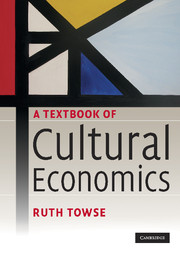Book contents
- Frontmatter
- Contents
- List of figures
- List of tables
- List of boxes
- List of abbreviations
- Preface
- Part I General issues in cultural economics
- Introduction
- 1 Introduction to cultural economics
- 2 Economic profile of the cultural sector
- 3 Markets for cultural goods and services
- 4 Economic organisation of the creative industries
- 5 Production, costs and supply of cultural goods
- 6 Consumption of cultural goods and services
- 7 Welfare economics and public finance
- Part II The ‘traditional’ economics of the arts and heritage
- Part III Artists' labour markets and copyright
- Part IV The creative industries
- Part V Conclusion and exercises and problems
- References
- Index
4 - Economic organisation of the creative industries
- Frontmatter
- Contents
- List of figures
- List of tables
- List of boxes
- List of abbreviations
- Preface
- Part I General issues in cultural economics
- Introduction
- 1 Introduction to cultural economics
- 2 Economic profile of the cultural sector
- 3 Markets for cultural goods and services
- 4 Economic organisation of the creative industries
- 5 Production, costs and supply of cultural goods
- 6 Consumption of cultural goods and services
- 7 Welfare economics and public finance
- Part II The ‘traditional’ economics of the arts and heritage
- Part III Artists' labour markets and copyright
- Part IV The creative industries
- Part V Conclusion and exercises and problems
- References
- Index
Summary
In this chapter, the present-day economic organisation of production in the creative industries is briefly described using the concepts introduced in the previous chapters: public or private finance, for-profit and non-profit enterprise, pricing policy, free or regulated markets, specialisation and integration in the chain of production. The chapter provides a background for the detailed analysis of the industries in Parts II and IV. It does not aim to cover all the creative industries, only the ones that are included in this book, and the focus is on the topics that have been dealt with in cultural economics: the art market, museums, publishing, the music industry, the performing arts and film.
Economic organisation refers to the way that firms and industries are structured and to the effect this has on markets – for example, whether there is monopoly or competition in the market, which in turn influences the price at which goods and services are supplied. Supply to a market involves a chain of production from the creation of the content through the production process, marketing and finally, delivery to consumers; in some industries these activities are vertically integrated, while in others there is less integration and more specialisation in markets for particular goods and services. Some industries have been subject to considerable technological change while others have not. Following on from chapter 3 and the economic history of cultural production, it can be seen that the past has had an influence on present-day economic organisation, although that influence is stronger in some industries than in others.
- Type
- Chapter
- Information
- A Textbook of Cultural Economics , pp. 76 - 103Publisher: Cambridge University PressPrint publication year: 2010



